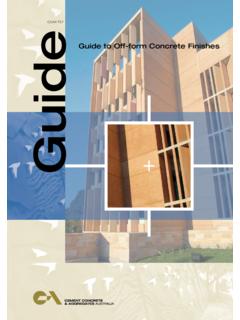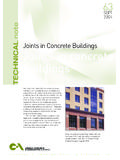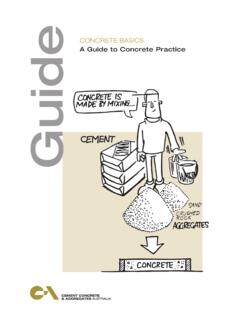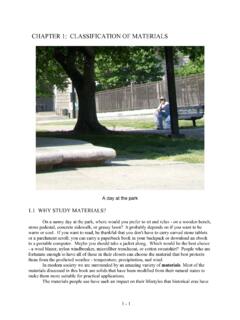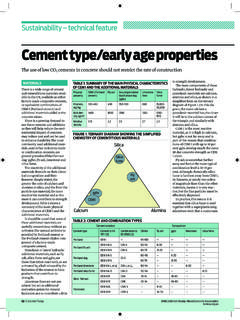Transcription of RESIDENTIAL Concrete Driveways and Paths
1 PAGE 1 OF 11 > RESIDENTIAL Concrete Driveways AND Paths RESIDENTIAL Concrete Driveways and Paths INTRODUCTION The basic function of RESIDENTIAL pavements such as Driveways , Paths and patios is to provide safe, easy access onto or around a property. Concrete is typically used to not only provide a durable paving surface, but one which can also incorporate a wide range of decorative finishes to complement the design and landscaping of the residence. While providing a Concrete pavement on the ground is relatively straightforward, there are many aspects of RESIDENTIAL pavement design and construction that need to be considered in order to produce a finished product that will satisfy both the functional and aesthetic requirements demanded by home owners.
2 This Data Sheet provides guidance on the planning, design, construction, maintenance and specification aspects that need to be considered to ensure a successful Concrete paving project. PLANNING Footpath Area Pavements between the kerb-and-gutter and property boundary will generally have to comply with the requirements of the Local Authority in respect of levels, grades and minimum details (thickness, reinforcement and minimum Concrete strength). These requirements will vary with different Local Authorities and should be determined initially, as they may affect the grades (and possible need for transition zones) for the remainder of the driveway, especially on steep slopes with short distances from the boundary to the house.
3 Pavement Grades To allow adequate drainage of the surface, the recommended minimum grade or cross-fall for a pavement is generally 1 in 100 (1%), or 10 mm per metre. The maximum grade should not exceed 1 in 20 (or 5%) in the footpath area or 1 in 4 (or 25%) within the property boundary. Note that as the actual requirements may vary from these limits, especially in hilly areas, it is always advisable to check this with the relevant Local Authority. Where grades steeper than are necessary for Driveways or where vehicles have low ground clearance, a transition zone at either end of the steep section may be required to prevent vehicles from bottoming on the driveway (see Figure 1).
4 Figure 1: Transition zones for Driveways DEC 2017 PAGE 2 OF 11 > RESIDENTIAL Concrete Driveways AND Paths Drainage The storm-water drainage system (including pavement levels and/or falls) should ensure that there is no ponding deeper than 10 mm on the surface 15 minutes after the cessation of rainfall. Where a pavement can t be graded away from a building ( Driveways that slope toward the house), a suitable drain should be provided adjacent to the building to divert storm-water run-off. Trees The presence of trees adjacent to the pavement may cause soil movements that change the ground levels and result in cracking of the pavement.
5 Particularly with expansive clays, the moisture drawn by tree roots can dry the soil, causing it to shrink and affect the pavement levels. More directly, tree roots may find their way under the pavement and cause damage by lifting sections of the slab. Further information can be found in BTF 183. Adjacent Structures Where Driveways and pavements are constructed adjacent to houses and other structures, a number of items may need to be considered: Termite barriers. It is important not to construct the pavement at a level that will obstruct any required visual termite inspection zone. Finished levels.
6 The National Construction Code 2 (NCC) requires paved areas that have a slope away from the building of at least 50 mm (25 mm in Low Rainfall Areas) over the first 1 m from the building to be at least 50 mm (100 mm in in Low Rainfall Areas or with sandy, well drained soils) below the finished surface of the adjacent slab-on-ground. This minimum height may need to be increased if the required slope can t be provided, there is a possibility of flooding, or local plumbing regulations require specific heights between the overflow relief gully and drainage fittings and ground/paving level. Flashings and damp-proofing courses.
7 The NCC requires that the height of a damp-proofing course or flashing serving as a damp-proofing course be at least 75 mm above the finished surface level of the paving adjacent to the wall. Sub-floor ventilation openings. If any existing sub-floor ventilation openings are covered by the paving, the NCC requires new openings to be provided to reinstate the required ventilation area. Ground Movement. In clay soils, the moisture content of the soil beneath areas of large paving may change over time, possibly causing movement of the soil and consequent changes to the paving and adjacent building levels.
8 The possible effects of this movement on the drainage and adjacent walls should be considered. Surface Finish While the range of surface finishes possible with Concrete is too extensive to cover here, a surface finish appropriate for the application must be selected. Items to be considered when selecting/specifying finishes include: Grade of pavement. Steep pavements generally require a coarse surface texture to provide skid and slip resistance, especially if a surface sealer is applied. Depending on the grade, steel troweled, polished, stamped and smooth aggregate type finishes may be unsuitable.
9 Coarse broom, tined, dragged and stenciled finishes would be more suitable. Also, exposed aggregate finishes may require an angular (crushed) coarse aggregate instead of a smooth rounded coarse aggregate. Slip resistance. Some surface texture is required to provide slip resistance, particularly in wet conditions. Note that if the pavement is subject to barefoot traffic ( around a pool) the texture should not be too coarse. Suitable finishes for these applications include wood float, light broom and smaller sized smooth exposed aggregate. Cleaning. For pavements subject to spills ( barbeque, outdoor kitchen and eating areas), smooth finishes are the most appropriate since they are easier to clean and maintain.
10 Use of a surface sealer can prevent spillage from penetrating the Concrete and facilitate cleaning. DESIGN Concrete - Strength The majority of Concrete used in RESIDENTIAL pavements is Normal class Concrete with a minimum strength of 20 MPa ( N20 Concrete ) in accordance with AS13791. A higher strength may be required in certain situations, for example: Heavier Loads. If the pavement is being used by vehicles between 3 ton and 10 ton gross mass, and infrequently by heavier vehicles that do not exceed the statutory limits for tyre, wheel and axle loads, an N25 Concrete is recommended.

